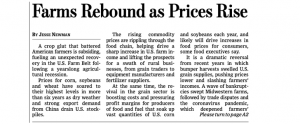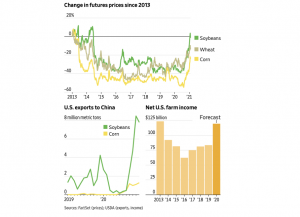Bloomberg's Leah Nylen reported Thursday that "a Colorado judge issued an order temporarily blocking the proposed $25 billion merger of Kroger Co. and Albertsons Cos., which has been challenged by…
Corn, Soybean Prices Have Soared, Adding Firmness to Farmland Values
Jesse Newman reported on the front page of Saturday’s Wall Street Journal that, “A crop glut that battered American farmers is subsiding, fueling an unexpected recovery in the U.S. Farm Belt following a yearslong agricultural recession.

“Prices for corn, soybeans and wheat have soared to their highest levels in more than six years as dry weather and strong export demand from China drain U.S. stockpiles.
The rising commodity prices are rippling through the food chain, helping drive a sharp increase in U.S. farm income and lifting the prospects for a swath of rural businesses, from grain traders to equipment manufacturers and fertilizer suppliers.
The Journal article stated that, “It is a dramatic reversal from recent years in which bumper harvests swelled U.S. grain supplies, pushing prices lower and slashing farmers’ incomes. A wave of bankruptcies swept Midwestern farms, followed by trade disputes and the coronavirus pandemic, which deepened farmers’ struggles.
“Now, China’s push to increase pork production and fulfill recent trade commitments are propelling huge volumes of U.S. crops overseas. American food processors and manufacturers also are racing to ensure they have adequate grain and oilseed supplies to meet burgeoning consumer demand. Inventories of corn, soybeans and wheat are on track this season to hit their lowest in at least six years, according to U.S. Agriculture Department forecasts.”

Ms. Newman explained that, “Farmers emboldened by the turnaround could sow crops this spring over the largest area since 2014, some agricultural economists and analysts say, planting corn and soybeans on millions of acres kept out of production by regional wet weather the past two seasons.”
Saturday’s article added that, “Stronger commodity markets already are pushing up farmland values, according to farmers, lenders and land managers. David Englund, chief executive of Farmers National Company, said the farm-management company last fall sold some parcels of land at prices that neared those last seen in 2012, during the last farm boom.”

In additional news regarding farmland values, an update earlier this month from Farmers National Company stated that, “What started out with better than expected sales prices at land auctions prior to fall harvest extended into very strong prices at some auctions during October and November, surprising many.”
The update noted that, “Agricultural land prices have been fairly stable in the past several years despite the gyrations of the ag economy. Producer incomes were taking hits, but the land market took it in stride except for the hardest hit areas or segments. The factors supporting the land market remained constant during this time, which included historically low interest rates, a lower supply of land for sale and adequate demand for good cropland about everywhere.
“The demand for land is the driver of the current land price surge.”
Higher commodity prices and the historic influx of government payments in 2020 have helped the financial condition of many farmers and therefore their interest in productive land.
And Bill Spiegel reported last week at Successful Farming Online that, “Constant demand for farmland plus higher grain prices is a great combination for folks selling farmland in northwest Iowa.”





